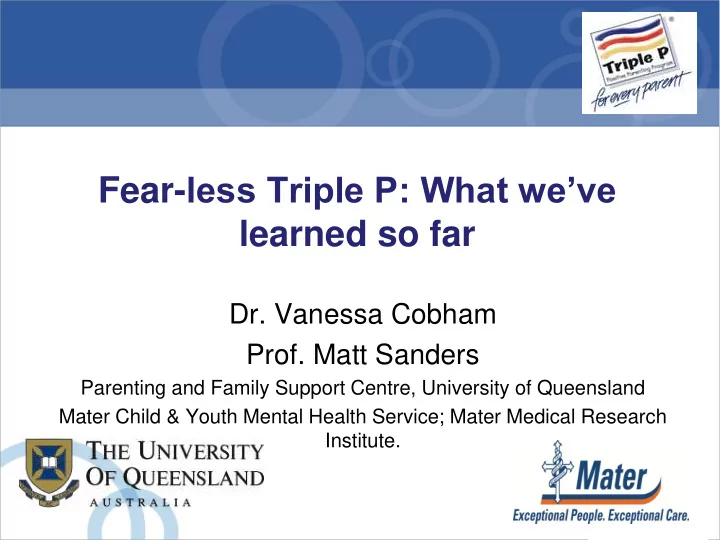

Fear- less Triple P: What we’ve learned so far Dr. Vanessa Cobham Prof. Matt Sanders Parenting and Family Support Centre, University of Queensland Mater Child & Youth Mental Health Service; Mater Medical Research Institute.
The significance of anxiety in children and adolescents • Most common form of psycho- pathology reported by children • Psychosocial consequences – School & social performance – Physical health problems • Poor prognosis • The families of anxiety-disordered children • The poor reach of existing treatments
Treatment outcome research: What do we know? • Child-focused CBT = gold standard – is an efficacious & useful treatment for anxiety in children (Cartwright-Hatton et al., 2004; Chorpita & Daleiden, 2007). – Across studies, the average remission rate at post-treatment is 56.5%. – That’s not bad. BUT, of course, children live in families. • Child + parent interventions – unclear that involving parents enhances benefits • Parent-focused interventions
Introducing “Fear - less” Triple P • A 6-session parenting intervention (Cobham & Sanders, 2009) designed to: – Educate parents about anxiety in children; their own potential role in maintaining children’s anxiety; avoidance & exposure; mental flexibility; & helpful vs. less helpful parental responses to children’s anxiety; – Empower parents to take on their role as the most powerful agent for change for their children; and – Produce radiating effects within the families of anxiety-disordered children.
“Fear - less” Triple P pilot • N = 61 families with a child aged 7-14 meeting criteria for a clinically significant anxiety diagnosis on the ADIS-IV-C/P; • Random assignment to WL or “Fear - less” Triple P • Measures – Child: SCAS; EMBU-C – Parents: SCAS-P; EMBU-P; Parenting Scale; Parent Problem Checklist; Relationship Quality Index; DASS- 21; & Parenting Tasks Checklist • Follow-up points: post, 3-mth, 6-mth & 12-mth.
“Fear - less” Pilot: Diagnostic data (Cobham & Sanders, in preparation) % of children anxiety diagnosis-free 100 88 90 78 80 70 63 Post 60 3-mth 50 41 40 6-mth 30 12-mth 20 10 0 0 Fear-less Wait list
Child self-report data over time Time point SCAS EMBU EMBU EMBU EMBU CDI-S Total * Over- Emotional Rejection* Anxious protection* warmth parenting Pre 27.04 (12.63) 23.58 (3.61) 31.66 (4.39) 15.79 (3.08) 23.22 (4.77) 47.28 (6.08) WL 32.72 (16.34) 24.17 (4.09) 31.49 (5.34) 14.66 (2.33) 23.23 (5.34) 48.97 (11.56) Fear-less Post 27.9 (11.47) 23.86 (3.30) 31.45 (6.10) 16.05 (3.12) 20.73 (5.16) 47.22 (6.89) WL 23.7 (14.05) 23.75 (4.75) 31.48 (6.56) 17.13 (6.04) 22.14 (5.41) 49.09 (12.57) Fear-less 3-mth 15.76 (11.84) 23.14 (3.14) 32.48 (3.73) 15.41 (2.91) 20.04 (4.55) 44.31 (7.27) Fear-less 6-mth 13.82 (12.68) 21.48 (3.01) 32.79 (5.85) 12.95 (2.57) 17.22 (4.37) 43.42 (5.98) Fear-less 12-mth 18.48 (12.04) 22.17 (4.51) 33.38 (2.87) 13.78 (2.66) 20.22 (4.43) 37 (2.52) Fear-less
Parents’ questionnaire data over time • Mothers – Significant change over time on SCAS total; EMBU Over- protection; EMBU Emotional warmth; EMBU Rejection; DASS Anxiety scale; Parenting tasks checklist – behavioural self-efficacy; CBCL Internalizing scale; CBCL Externalizing scale – Trends for changes over time on EMBU Anxious Parenting; Parenting Scale (Laxness); Parenting Scale (Over-reactive) • Fathers – Significant change over time on EMBU Anxious Parenting
Conclusions and Future Directions Conclusions and Implications – Strong support for the efficacy of this brief, 6- session parenting intervention in the treatment of anxiety disordered children and adolescents – Exciting potential for extending reach (including previously ‘difficult to work with’ populations) – High level of acceptability to parents Future Directions 1. Replication in other sites & a larger RCT 2. How light could we go? 3. Mediators and moderators
Thank you. vanessa@psy.uq.edu.au
Recommend
More recommend